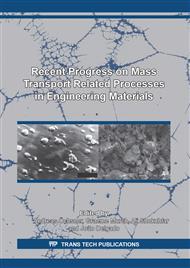[1]
R. B. Keey, Drying of loose and particulate materials. Hemisphere Publishing Corporation, New York, USA (1992).
Google Scholar
[2]
C. Strumillo, T. Kudra, Drying: principles, science and design. Gordon and Breach Science Publishers, New York, USA (1986).
Google Scholar
[3]
D. B.Brooker, F. W. Bakker-Arkema, C. W. Hall, Drying and storage of grains and oilseeds. AVI Book, New York, USA (1992).
Google Scholar
[4]
Z. Erbay, F. Icier, A review of thin-layer drying of foods: theory, modeling, and experimental results. Critical Rev. Food Sci. Nutrition 50(5) (2010)441–464.
DOI: 10.1080/10408390802437063
Google Scholar
[5]
E. K. Akpinar, Determination of suitable thin-layer drying curve model for some vegetables and fruits. J. Food Eng. 73(1) (2006) 75–84.
DOI: 10.1016/j.jfoodeng.2005.01.007
Google Scholar
[6]
M. I. Fadhel, R. A. Abdo, B. F. Yousif, A. Zaharim, K. Sopian, Thin-layer drying characteristics of banana slices in a force convection indirect solar drying. In: 6th IASME/WSEAS International Conference on Energy and Environment: Recent Researches in Energy and Environment, Cambridge, England, (2011)310–15.
Google Scholar
[7]
D. M. Kadam, R. K. Goyal, M. K. Gupta, Mathematical modeling of convective thin-layer drying of basil leaves. J. Med. Plants Res. 5(19) (2011)4721–4730.
Google Scholar
[8]
E. O. Akoy, Experimental characterization and modeling of thin-layer drying of mango slices. Int. Food Res. J. 21(5) (2014)1911-1917.
Google Scholar
[9]
D. A. Tzempelikos, A. P. Vouros, A. V. Bardakas, A. E. Filios, D. P. Margaris, Experimental study on convective drying of quince slices and evaluation of thin-layer drying models. Eng.Agricult.,Environm. Food 8(3) (2015)169–77.
DOI: 10.1016/j.eaef.2014.12.002
Google Scholar
[10]
H. Kucuk, A. Midilli, A. Kilic, I. Dincer, A review on thin-layer drying-curve equations. Drying Technol. 32(7) 757–73 (2014).
DOI: 10.1080/07373937.2013.873047
Google Scholar
[11]
M. Aghbashlo, M. H. Kianmehr, S. Khani, M. Ghasemi, Mathematical modeling of thin-layer drying of carrot. Int. Agrophysics 23(4) (2009)313–7.
Google Scholar
[12]
I. L. Pardeshi, S. Arora, P. A. Borker, Thin-layer drying of green peas and selection of a suitable thin-layer drying model. Drying Technol. 27(2)(2009)288–295.
DOI: 10.1080/07373930802606451
Google Scholar
[13]
W. P. Silva, C. M. D. P. S. Silva, F. J. A. Gama, Mathematical models to describe thin-layer drying and to determine drying rate of whole bananas, J. Saudi Soc.Agricult. Sci. 13(1)(2014) 67–74.
DOI: 10.1016/j.jssas.2013.01.003
Google Scholar
[14]
M. Parti, Selection of mathematical models for drying grain in thin-layers. J.Agricult. Eng. Res. 54(4)(1993)339-352.
DOI: 10.1006/jaer.1993.1026
Google Scholar
[15]
W. M. P. B. Lima, Heat and mass transfer in porous solids with complex shape via lumped analysis: Modeling and simulation, Master dissertation in Mechanical Engineering, Federal University of Campina Grande. Campina Grande, Brazil (2017). (In Portuguese).
DOI: 10.21475/ajcs.17.11.06.p569
Google Scholar
[16]
A. G. B. Lima, S. R. Farias Neto, W. P. Silva, Heat and mass Transfer in Porous Materials with Complex Geometry: Fundamentals and Applications. In: J. M. P. Q. Delgado. (Org.). Heat and Mass Transfer in Porous Media. Series: Advanced Structured Materials. 1ed.Heidelberg (Germany): Springer-Verlag, 13(2011)161-185.
DOI: 10.1007/978-3-642-21966-5_7
Google Scholar
[17]
V.S. Silva, J.M.P.Q. Delgado, W.M.P. Barbosa de Lima, A.G. Barbosa de Lima, Heat and mass transfer in holed ceramic material using lumped model. Diff. Found. 7 (2016)30-52.
DOI: 10.4028/www.scientific.net/df.7.30
Google Scholar
[18]
M. A. Munem, D. J. Foulis, Calculus, Guanabara Dois S.A., Rio de Janeiro, Brazil. 1 (1978). (In Portuguese).
Google Scholar


